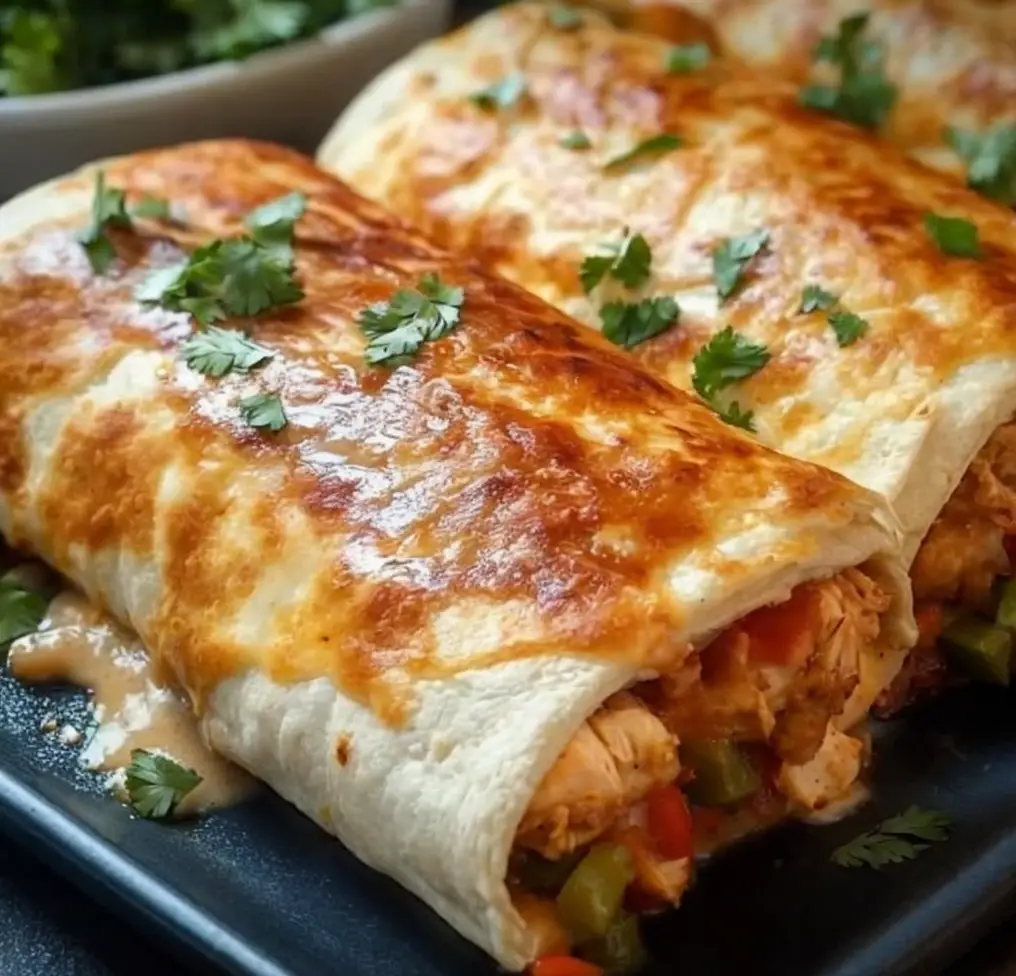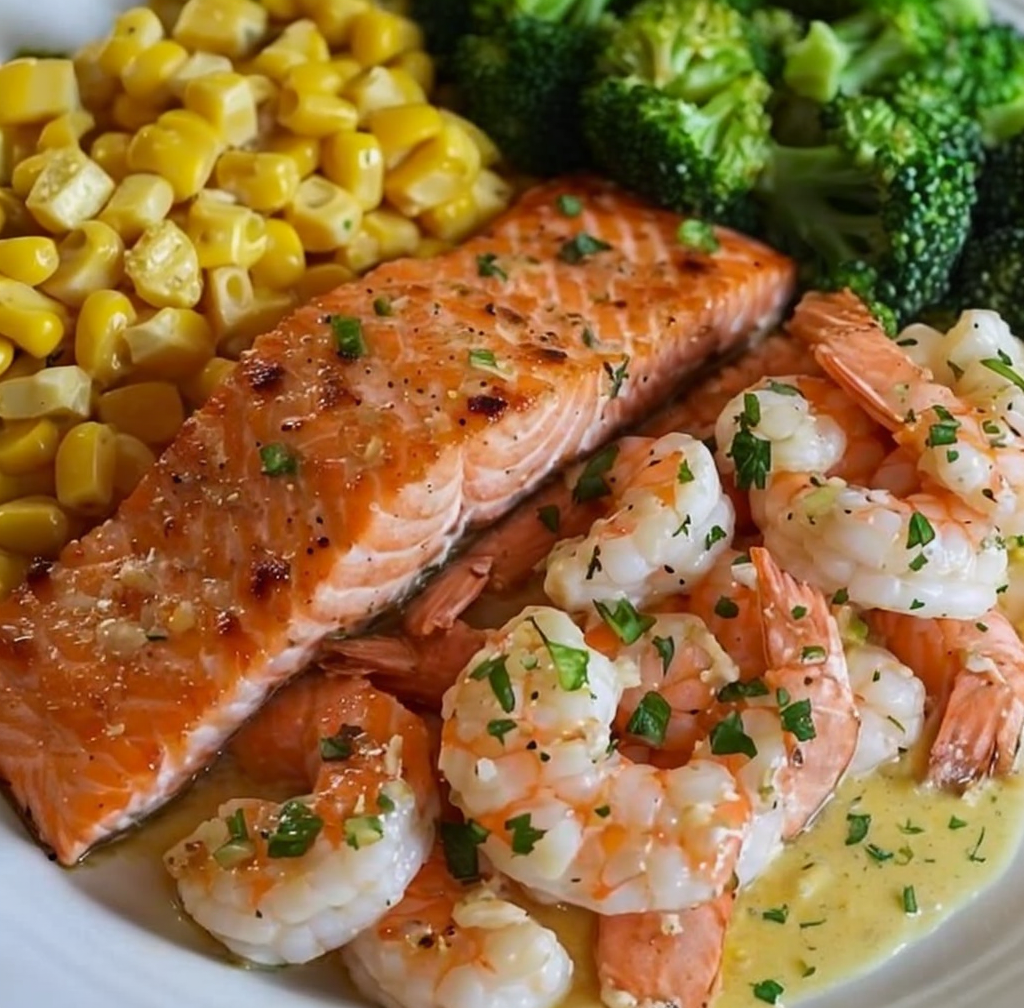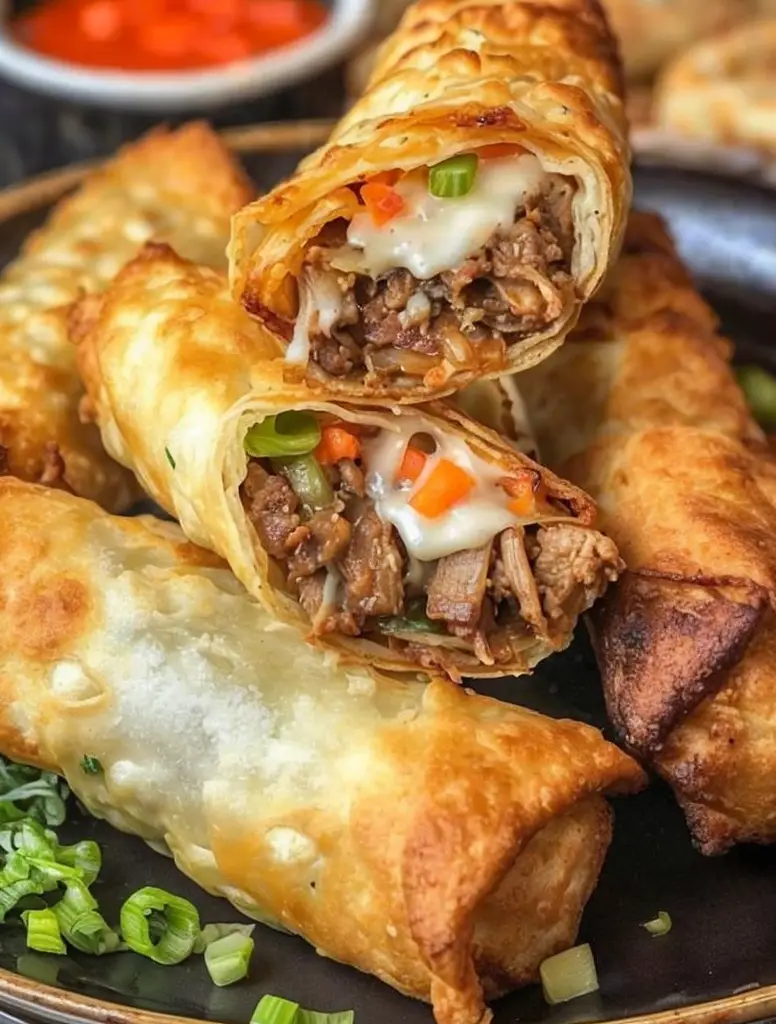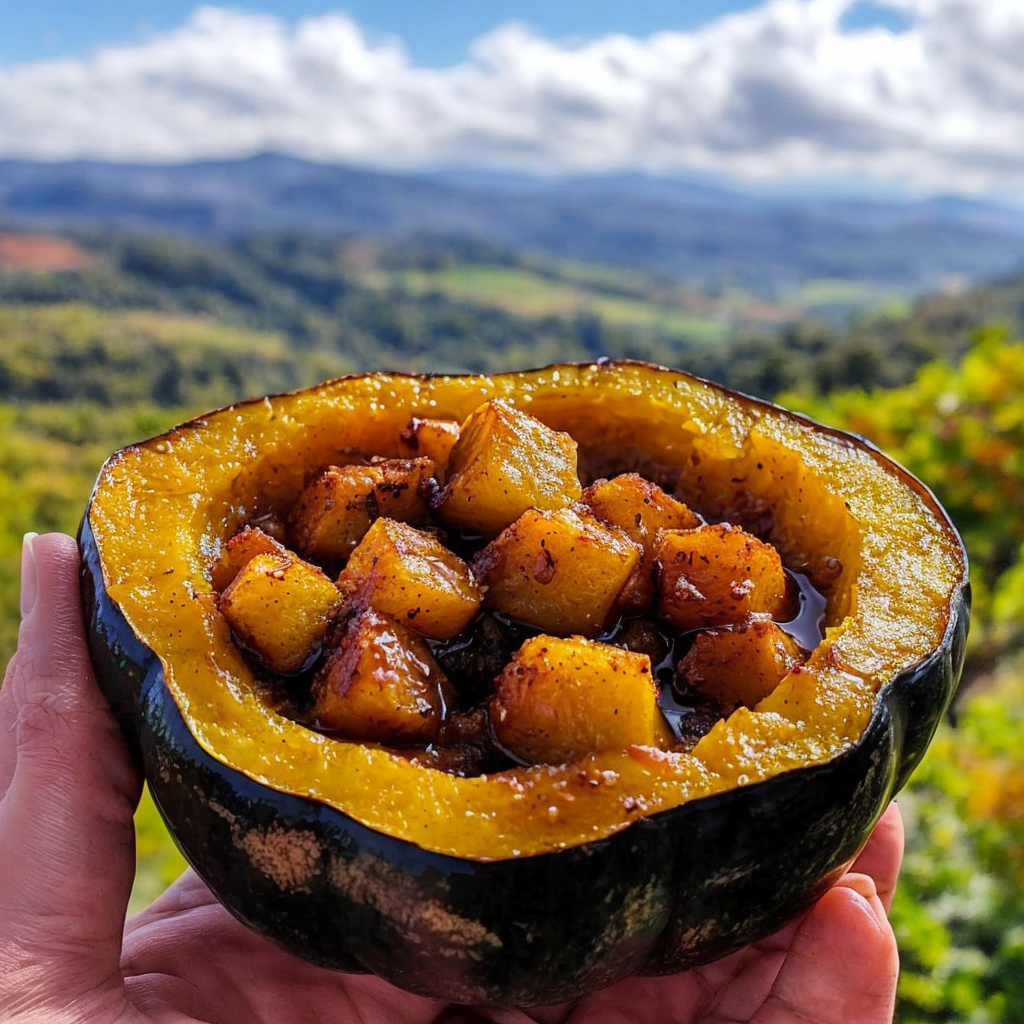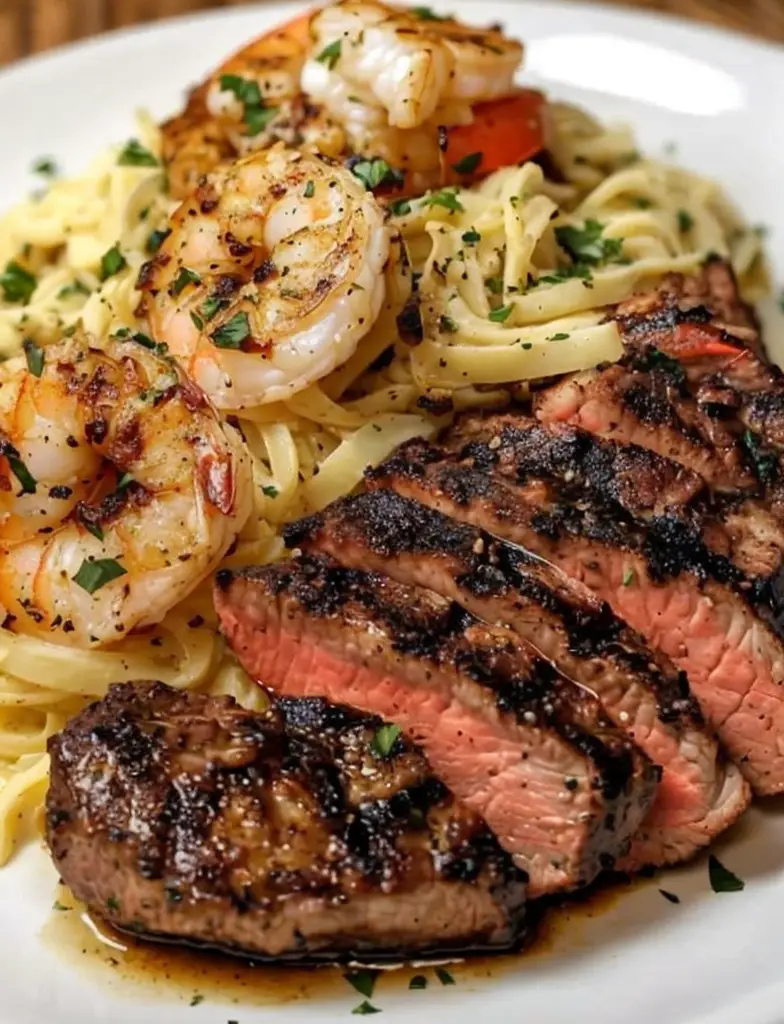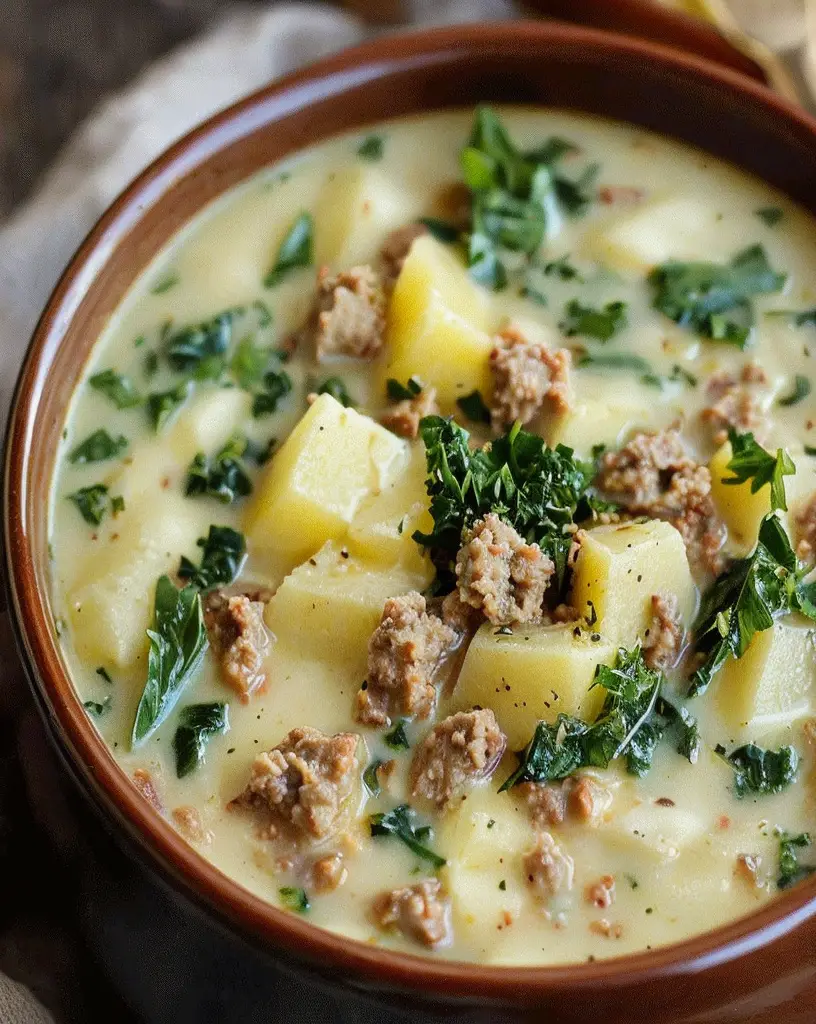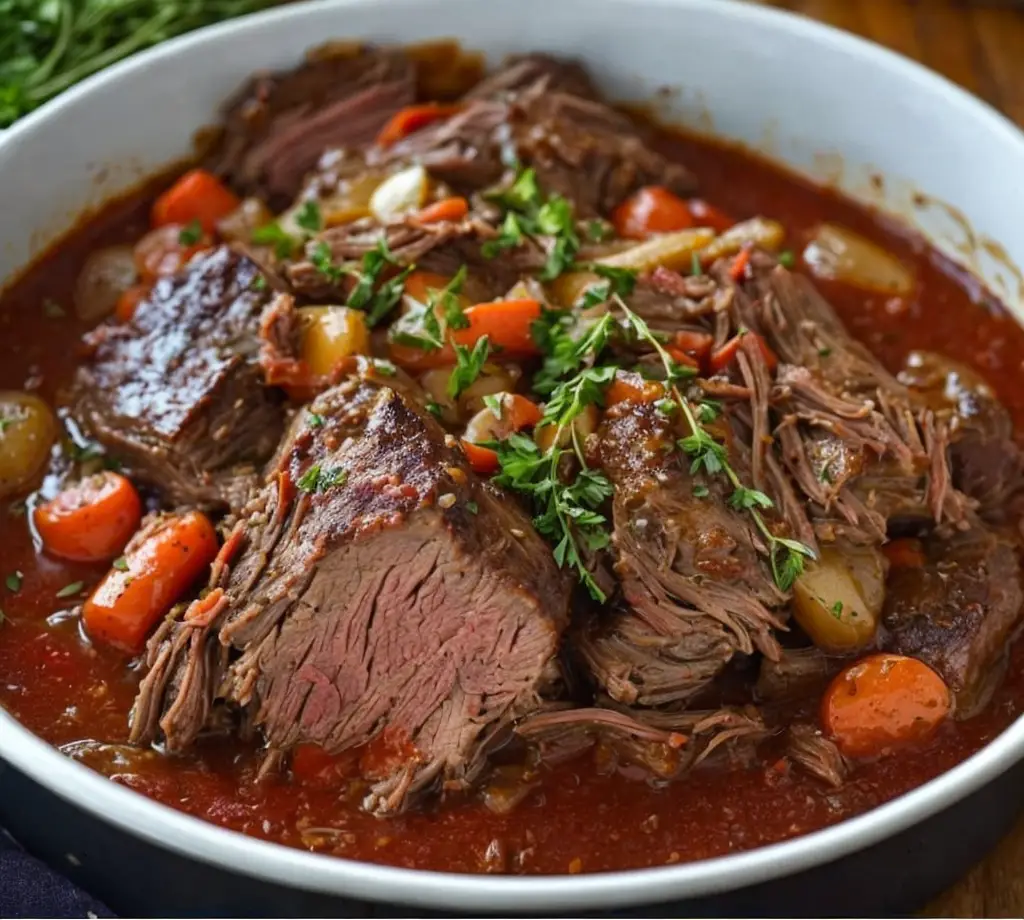Baked Chicken Chimichangas: A Delicious Twist on a Classic Favorite
Are you craving a Mexican delight that’s both hearty and healthy? Baked Chicken Chimichangas are the perfect solution. Unlike their deep-fried cousins, these chimichangas offer the same delightful crispiness without the extra calories, making them a fantastic choice for a satisfying dinner. This recipe combines tender chicken with a medley of spices, creating an irresistible filling wrapped in a golden, baked tortilla.
The enticing aroma of warm spices such as cumin and paprika fills the kitchen as these chimichangas bake to perfection. Each bite offers a harmonious balance of flavors, from the savory chicken to the creamy cheese, all nestled inside a perfectly baked tortilla shell. This delightful dish transforms any mealtime into a festive celebration with its burst of colors and rich tastes.
Baking these chimichangas instead of frying saves on time without sacrificing flavor. This method not only makes the dish healthier but also simpler. So the next time you’re short on time but still want to impress your family or friends, turn to this baked version of chicken chimichangas.
Quick Recipe Highlights
- Flavor Profile: A savory blend of cumin, garlic, and paprika envelops the moist chicken and cheese, offering a burst of authentic Mexican flavors in every bite.
- Texture: Experience a perfect crunch from the baked tortillas, contrasting beautifully with the juicy, tender chicken inside.
- Aroma: Soothing notes of spices intermingle with the aroma of freshly baked tortillas, enticing guests from the moment they enter your home.
- Visual Appeal: A set of vibrant golden-brown chimichangas with a tantalizing oozing of cheese, garnished with fresh cilantro and lime wedges.
- Skill Level Needed: Ideal for home cooks with basic kitchen skills, this recipe requires simple techniques to achieve optimal results.
- Special Equipment: A baking sheet and parchment paper are essential to ensure even baking and prevent sticking.
Recipe Overview
- Difficulty Level: This recipe requires a moderate skill level due to the need to precisely season the chicken and appropriately wrap the chimichangas to ensure even baking.
- Category: Perfect for a family dinner or casual dinner party, these baked chimichangas are filling and satisfying.
- Cuisine: Drawing from traditional Mexican cuisine, this dish highlights flavors and techniques that celebrate Mexican culinary heritage.
- Cost: Affordable, as it uses readily available ingredients, this dish fits well within a mid-range budget without compromising on flavor.
- Season: Suitable year-round, especially in the fall and winter when oven-baked meals are particularly comforting and inviting.
- Occasion: Ideal for weeknight dinners, casual get-togethers, and even appetizers for larger gatherings when cut into smaller portions.
Why You’ll Love This Recipe
With its irresistible taste and satisfying texture, baked chicken chimichangas quickly become a family favorite. The recipe combines the savory flavor of seasoned chicken with the satisfying crunch of a baked tortilla. The tantalizing contrast between the crispy exterior and the gooey cheesy center keeps you coming back for more.
Not only is this dish delicious, but it’s also highly convenient and straightforward to prepare. With minimal prep and clean-up involved, you can have a delightful meal ready in under an hour. The use of common pantry staples further enhances the ease of creation, while the baking method promotes a healthier option compared to frying.
Nutritionally, the baked chicken chimichangas provide a good balance of protein, carbohydrates, and essential nutrients. Using lean chicken ensures lower fat content, while the addition of cheese supplies calcium and a touch of indulgence. The baked approach further minimizes calorie intake, making this meal a guilt-free indulgent choice.
For social gatherings, these chimichangas offer not only great taste but also ease of serving. Thanks to their structured form, they are easy to handle and enjoy without utensils, making them perfect for social settings and buffets. Guests will be impressed by the rich and vibrant flavors, which encourage lively conversation and enjoyment.
Finally, the cost-effectiveness and accessibility of the ingredients make this dish an excellent choice for budget-conscious cooks. With versatile components, this recipe is adaptable to what’s already in your kitchen, avoiding the need for special trips to the grocery store. This aspect contributes to its appeal as an everyday, yet special meal choice.
Historical Background and Cultural Significance
Chimichangas carry a rich origin story, steeped in Mexican culinary traditions. While its exact inception is contested, many believe chimichangas originated in northern Mexico, evolving from the traditional burrito. The dish has been deeply rooted in the cross-border culinary exchanges between Mexico and the southwestern United States.
Culturally, chimichangas are a quintessential component of Mexican-American cuisine, symbolizing the blend of traditions and flavors that have characterized the border regions. Over time, they have become a staple in Tex-Mex restaurants and home kitchens alike, celebrated for their robust flavors and comforting texture.
The recipe has evolved from its original fried preparation to include variations such as our baked chicken chimichangas. This evolution reflects contemporary concerns over health and nutrition while maintaining the core qualities that make chimichangas so beloved. As part of the trend towards reducing caloric intake without sacrificing flavor, this baked version offers a modern twist on a time-honored favorite.
Regional variations abound, with each area imparting its unique twist to the traditional chimichanga recipe. While beef remains a popular filling, chicken provides a lighter yet equally flavorful alternative, ideal for those seeking variety in their culinary experience. The baked rendition, in particular, has gained popularity for its ease of preparation and healthy profile.
Ingredient Deep Dive
Chicken, the star of this dish, carries its own cultural and nutritional significance. As a widely consumed protein across the globe, chicken features prominently in many traditional and contemporary dishes. In Mexican cuisine, it’s revered for its versatility and ability to carry the rich flavors of spices and sauces.
Nutritionally, chicken is a lean protein choice, offering a high amount of protein with minimal fat content. It’s an excellent source of B-vitamins and essential minerals, contributing to its appeal as a staple ingredient in health-conscious diets. When selecting chicken, opt for free-range or organic varieties when possible to enhance flavor and environmental sustainability.
Cheese is another vital component, adding creaminess and depth to the chimichangas. Traditionally, a softer cheese like Monterey Jack or cheddar works well, melting smoothly into the filling. Cheese contributes not only flavor but also nutritional value, providing calcium and protein.
For optimal storage, keep cheese in its original packaging or a sealed container in the refrigerator to maintain freshness. If substituting, consider using a low-fat version or alternative plant-based cheese for a healthier or vegan adaptation.
Common Mistakes to Avoid
- Overfilling tortillas: This can cause splitting or bursting during baking. Use moderation to ensure a tidy wrap.
- Skipping the tortilla warming step: A warm tortilla is more pliable, preventing cracks and encouraging an even bake.
- Underseasoning the chicken: Season generously to enhance flavor and ensure the filling isn’t bland.
- Improper wrapping technique: Wrapped too loosely, the filling may spill out. Wrap tightly without tearing the tortilla.
- Using high-fat cheese: Opt for a balanced cheese to prevent overly greasy chimichangas.
- Skipping parchment paper for baking: This can lead to sticking and uneven baking. Use parchment for best results.
- Ignoring recommended oven temperature: The right temperature is crucial for achieving the desired crispiness.
- Baking too close together: Spaces the chimichangas slightly apart on the sheet for even airflow and browning.
- Not letting them rest: Allow after-baking rest for the chimichangas ensures the filling sets and is easier to slice.
- Skipping garnish: Fresh garnishes like cilantro or lime add visual appeal and a burst of freshness.
Essential Techniques
Mastering the wrap is crucial to achieving perfect baked chimichangas. The technique involves evenly spreading the filling, folding the sides inward, and rolling tightly towards the open end. Ensuring the filling is snug and the tortilla properly sealed will help maintain the chimichanga’s shape and prevent leakage during baking.
Baking at the right temperature seals in the flavors and creates a beautifully crisp exterior while keeping the inside tender. Pay attention to the color and texture changes, aiming for a golden hue as an indicator of doneness. Avoid opening the oven frequently to preserve consistent baking conditions.
Seasoning the chicken adequately involves layering spices, allowing the flavors to meld, and providing depth to the chimichanga. This enhances the filling and contributes to the dish’s overall taste profile, making each bite flavorful and satisfying. Balance is crucial, ensuring no single spice overwhelms others.
Pro Tips for Perfect Baked Chicken Chimichangas
Line your baking sheet with parchment paper to avoid sticking and ensure even heat distribution. This will assist in achieving perfectly baked tortillas with minimal fuss.
Experiment with different fillings by incorporating other Mexican staples, such as beans or sautéed vegetables, to add variety and nutritional value to your dish.
For extra crispiness, brush the tortillas with a hint of oil before baking. This simple step enhances their texture, resulting in a lovely golden finish.
If you prefer a spicier kick, include a dash of hot sauce or jalapeños in the filling mixture, complementing the savory chicken and cheese.
Monitor baking time closely, as ovens may vary. Look for cues such as a light golden color and firm tortillas to indicate readiness, ensuring a satisfying crunch upon serving.
Consider preparing additional fillings in advance to enjoy quick and easy homemade meals. Pre-prepped fillings allow you to assemble and bake chimichangas at a moment’s notice for fresh, convenient dining.
Variations and Adaptations
Regional variations offer exciting twists on classic chimichangas. In the Southwest, additional beans or corn provides an extra layer of flavor and texture, enhancing the dish’s complexity. Meanwhile, cilantro and lime deliver the bright, zesty notes characteristic of coastal Mexican cuisine.
For seasonal adaptations, add roasted fall vegetables like sweet potatoes or squash for a heartier meal. These elements complement the warming spices of the filling, making them particularly appealing in autumn.
Dietary modifications, such as using whole wheat tortillas or low-fat cheese, create healthier variations without compromising taste. For those following a plant-based diet, substitute chicken with tofu or jackfruit and include plant-based cheese options.
The flavor palette can be adjusted to suit personal preferences, such as incorporating chipotle for a smoky undertone or adding fresh herbs for a refreshing twist. These variations maintain the dish’s integrity while offering new dimensions of taste.
Texture modifications, such as experimenting with crunchier alternatives like almond flour tortillas, provide an unexpected change of pace. Additionally, finely diced vegetables in the filling introduce diversity in mouthfeel.
Presentation alternatives can bring visual appeal, whether serving chimichangas whole or slicing them into smaller portions for appetizers. Pair with colorful side salads or salsas to enhance the dining experience.
Serving and Presentation Guide
Plating the chimichangas with vibrant garnishes elevates your presentation. Consider topping with fresh, chopped cilantro or a squeeze of lime juice for bursts of color and added freshness, complementing the golden chimichangas.
Garnishing ideas include creamy avocado slices, a dollop of sour cream, or a spoonful of zesty salsa to enhance the visual and taste appeal of your dish. These additions create a delicious harmony and invite guests to indulge.
Traditional accompaniments like Mexican rice or refried beans further enrich the meal, offering a harmonious balance and completing the traditional dining experience. Choose pairings that enhance the flavors and textures of the chimichangas while maintaining authenticity.
For modern serving suggestions, present chimichangas with a mixed greens salad topped with a light vinaigrette. The refreshing crunch adds contrast, balancing the richness of the baked tortilla.
Temperature considerations are essential for optimal taste and texture satisfaction. Serve the chimichangas hot from the oven, allowing flavors to meld and cheese to ooze gently, amplifying the enjoyment of each bite.
Portion control tips include serving one chimichanga per person as a main course or slicing them into smaller pieces for casual gatherings. This provides flexibility and accommodates varied appetites.
Wine and Beverage Pairing
Pairing chimichangas with a crisp, chilled white wine like Sauvignon Blanc can accentuate the bright flavors of the dish without overshadowing the savory notes of the chicken and cheese. A slightly acidic wine complements the richness, offering a delightful harmony.
Non-alcoholic alternatives such as sparkling water infused with lime or lemon echo the zesty flavors of the chimichangas while providing a refreshing palate cleanser. These choices help maintain the festive atmosphere without diminishing the experience.
Coffee or tea pairings, specifically a strong iced coffee or a lightly sweetened hibiscus tea, offer a contrast to the savory elements of the dish. These beverages balance the meal without overwhelming the taste buds, creating a cohesive dining experience.
Temperature considerations suggest chilled beverages to accompany the meal, providing a refreshing contrast to the warm chimichangas. Alcoholic or non-alcoholic, ensure selections are served at an ideal temperature to enhance enjoyment.
Serving suggestions include presentation in elegant glassware for a sophisticated touch or colorful pitchers for a more relaxed setting. Both options encourage sharing and conversation, drawing guests into a welcoming and engaging meal.
Storage and Shelf Life
Proper storage of baked chimichangas ensures their freshness and quality over time. Once cooled, store them in an airtight container in the refrigerator for up to three days, preserving flavors and preventing spoilage.
Temperature requirements for storage should be adhered to strictly. Keep chimichangas at a consistent cool temperature to maintain freshness and minimize the risk of spoilage or contamination.
Container recommendations include sealable plastic bags or airtight containers, which protect against freezer burn and maintain the chimichangas’ texture when stored. Ensure the storage medium is secure and airtight for the best results.
Signs of spoilage include an off-putting smell, change in texture, or visible mold. Discard any chimichangas exhibiting these traits to avoid health risks, emphasizing the importance of proper storage.
Reheating instructions are straightforward. For best results, reheat chimichangas in the oven to retain crispness, maintaining their enjoyable texture. Alternatively, use a microwave for quick reheating, though this may result in a softer tortilla.
Freezing guidelines allow for long-term storage up to three months. Wrap each chimichanga individually in plastic wrap and aluminum foil to prevent freezer burn, ensuring they are ready when you crave them later.
Make Ahead Strategies
For busy days, consider pre-cooking the chicken and assembling the filling ahead of time. Store the prepared filling in a sealed container, ready to use when you assemble the chimichangas.
The prep timeline allows you to spread preparation over several days. Cut down the workload by preparing components in advance, reducing stress and maximizing convenience on the day of serving.
Storage between steps plays a vital role in maintaining the quality of your components. Keep prepped ingredients refrigerated until assembly to ensure freshness and flavor integrity.
A quality impact assessment suggests the recipe remains flavorful even when made ahead. By preempting steps, you not only shorten the preparation time but retain the dish’s intended taste.
Assembly tips focus on streamlining the wrapping process. Arrange all components within reach to foster efficiency, allowing for seamless construction of the chimichangas.
Reheating guidelines ensure you enjoy hot, crispy chimichangas even if made in advance. The oven or toaster oven restores the desired crunch, faithful to the original dish.
Fresh element additions at the time of serving include garnishes like fresh cilantro or lime, which elevate the dish’s flavor and presentation with minimal effort.
Scaling Instructions
Halving the recipe is straightforward and accommodates smaller gatherings or intimate meals. Simply adjust the quantities of each ingredient, maintaining the same ratio for consistent flavor.
Doubling or tripling the recipe is ideal for larger parties. Assess oven capacity and consider baking in batches if necessary to ensure each chimichanga bakes evenly and retains its quality.
Equipment adjustments are essential when scaling. Use multiple baking sheets to accommodate increased quantities, ensuring adequate space between chimichangas for even cooking.
Timing modifications may be necessary based on oven capacity and increased batch size. Monitor cooking times and modify slightly if needed, checking for ideal doneness.
Storage considerations for bulk preparation allow for frozen storage of extras, ensuring delicious homemade meals are always within reach. Maintain quality and prevent freezer burn through proper wrapping methods.
Nutritional Deep Dive
A macro breakdown reveals that baked chicken chimichangas provide a balanced mix of proteins, carbohydrates, and fats, making them a comprehensive meal choice. Lean chicken offers the primary protein source, contributing to muscle maintenance and repair.
Micronutrient analysis highlights the presence of essential vitamins and minerals. Chicken supplies B vitamins and iron, while cheese adds calcium, supporting bone health and overall well-being.
Health benefits are numerous, offering an appetizing way to meet nutritional needs. Lean proteins and wholesome fats maintain energy levels and satiety, appealing to those seeking health-conscious meals.
Dietary considerations accommodate diverse preferences. Whole grain tortillas and low-fat cheese options tailor the chimichangas to specific lifestyles, highlighting their versatility and adaptability to various diets.
Portion analysis suggests serving one chimichanga as part of a balanced meal. This ensures a satisfying dining experience while maintaining dietary goals and contributing to healthy eating habits.
Weight management tips encourage pairing the chimichangas with colorful vegetable sides or salads, balancing meal composition and enhancing satiety while enjoying a flavorful treat.
Dietary Adaptations
To create gluten-free baked chicken chimichangas, substitute traditional tortillas with certified gluten-free varieties. Be sure to verify all other ingredients for hidden gluten sources to maintain adherence to the dietary requirement.
For a dairy-free rendition, replace the traditional cheese with a plant-based alternative. Consider nutritional yeast or cashew cheese as suitable substitutes, offering the creamy texture without dairy content.
To craft a vegan version, swap chicken for marinated tofu or jackfruit and use plant-based cheese alternatives. This maintains the dish’s flavors and textures while adhering to vegan principles.
Low-carb enthusiasts can replace tortillas with cabbage or coconut wraps for a lighter, carb-conscious twist. These alternatives offer structural integrity while contributing minimal carbohydrates.
Following a keto diet is simplified by adjusting cheese to a high-fat, low-carb variety and ensuring the tortilla aligns with ketogenic criteria. This emphasis on healthy fats complements the lifestyle.
A Paleo adaptation suggests using almond flour tortillas and eliminating cheese in favor of nuts or seeds for texture. This maintains the essence of the dish within Paleo guidelines.
Low-FODMAP considerations focus on ingredient selection. Use lactose-free cheese and appropriate low-FODMAP tortillas to meet dietary needs, ensuring a comfortable and enjoyable dining experience.
Troubleshooting Guide
Texture issues often arise from uneven baking. Use parchment paper to prevent sticking and ensure even heat distribution across the baking sheet.
Flavor balance can be disrupted if seasoning is inadequate. Taste-test seasonings before filling the tortillas to ensure robust and satisfying flavors in the chimichangas.
Temperature problems stem from incorrect oven settings. Adjust accordingly and monitor visual indicators such as color and crispness to guide baking time.
Equipment challenges may occur with overcrowding on the baking sheet. Use additional sheets or bake in smaller batches for optimal results and consistent quality.
Ingredient substitutions require careful consideration to avoid unexpected results. Choose alternatives with similar textures and flavors to maintain the integrity of the finished chimichangas.
Timing concerns are best addressed through close attention to baking cues. Avoid relying solely on time recommendations, using sensory and visual assessments for precise outcomes.
Recipe Success Stories
Community feedback highlights the wide acclaim baked chicken chimichangas have garnered. Home cooks appreciate the simplicity and flavor, sharing adaptations and successes across various platforms.
Variation successes include unexpected yet delightful additions such as avocado or bell peppers, showcasing the dish’s versatility and capacity for personalization.
Adaptation stories often emphasize dietary modifications, from gluten-free to vegan versions. Creative cooks share their experiences, celebrating successful renditions that retain the chimichangas’ essence.
Reader suggestions frequently involve innovative serving ideas or garnishing tips, broadening the dish’s appeal and application. These insights nurture community engagement and inspiration.
Photography tips shared within the community emphasize presentation techniques, enhancing social media sharing and showcasing the vibrant colors and textures of the chimichangas.
Frequently Asked Questions
How do I ensure the chimichangas stay crispy? Ensure even baking by placing parchment on the baking sheet, and avoid overcrowding. A light brush of oil on the tortillas before baking enhances crispiness.
What are the best cheese substitutes for a dairy-free version? Plant-based cheeses such as nutritional yeast, almond cheese, or cashew cheese work well, providing similar creaminess and taste without dairy.
Can I use leftover chicken for this recipe? Absolutely! Repurpose leftover chicken by shredding and seasoning it to achieve the desired flavors, reducing preparation time and minimizing food waste.
How do I reheat frozen chimichangas? For best results, thaw in the refrigerator overnight, then reheat in the oven for ten minutes at 350°F, preserving texture and flavor.
Are there low-carb tortilla alternatives? Yes, low-carb wraps such as coconut or almond flour tortillas offer a suitable substitute, meeting dietary preferences without sacrificing quality.
Is this recipe suitable for meal prep? Baked chicken chimichangas lend themselves well to meal prep. Store prepared chimichangas in the refrigerator or freezer, ready to bake or reheat.
Can I grill instead of baking? Grilling provides a unique flavor but requires diligent attention to avoid burning. Monitor grill temperature and cook chimichangas until sufficiently crispy, flipping as needed.
What can I pair with chimichangas for a full meal? Consider serving with Mexican rice, refried beans, or a crisp salad for a balanced and satisfying meal experience.
What types of beverages complement chimichangas? Bold and crisp white wines, sparkling water with citrus, or iced coffee variants complement the flavorful notes of the chimichangas beautifully.
Additional Resources
For more exciting Mexican-inspired recipes, consider exploring enchiladas, tacos, or tamales, each offering unique flavors and techniques to broaden your culinary skills and appreciation.
Technique guides focused on mastering spice blends and seasoning perfectly can elevate your chimichanga experience through intentional flavor enhancement and balance, contributing to a memorable meal.
Ingredient information highlights the diversity of tortilla options and cheese varieties, encouraging experimentation and adaptation based on dietary preferences and taste discoveries.
Equipment recommendations ensure a seamless cooking process, suggesting reliable brands for baking sheets, utensils, and containers that contribute to consistent and satisfying results.
Sneak in seasonal variations by researching which fresh produce pairs best with the dish throughout the year. This guides ingredient choices, allows for nutritional optimization, and keeps dining experiences fresh.
Join the Conversation
Engage with fellow food enthusiasts online by sharing your baked chicken chimichanga creations across social media platforms. Use hashtags and tags to participate in lively discussions and exchanges.
Photography tips from the community enhance the visual appeal of shared culinary creations, inspiring others to attempt the recipe and explore adaptations or pairings.
Recipe reviews provide invaluable insights into personalized adaptations or attempts, fostering a sense of connection and shared experience among home cooks and food lovers.
Community engagement thrives on diverse recipe variations shared by creative cooks, motivating collective experimentation and appreciation for the versatility of baked chimichangas.
Feel inspired? Share your twist on the classic baked chicken chimichanga recipe and become a part of a dynamic community that values both tradition and innovation in culinary exploration.
The Recipe
Baked Chicken Chimichangas
Serves: 4
Prep Time: 20 mins
Cook Time: 25 mins
Total Time: 45 mins
Kitchen Equipment Needed
- Baking Sheet
- Parchment Paper
- Mixing Bowls
- Skillet
- Oven
Ingredients
- 2 cups cooked chicken, shredded
- 1 teaspoon cumin
- 1 teaspoon garlic powder
- 1 teaspoon paprika
- 1/2 teaspoon salt
- 1/2 cup shredded cheese
- 4 large flour tortillas
- 1 tablespoon vegetable oil
Directions
- Preheat oven to 400°F (200°C). Line a baking sheet with parchment paper.
- In a mixing bowl, combine shredded chicken, cumin, garlic powder, paprika, and salt.
- Lay a tortilla flat and place an even amount of chicken mixture on top. Sprinkle with cheese.
- Fold in sides of the tortilla and roll up tightly to enclose the filling.
- Place seam-side down on the prepared baking sheet. Repeat with remaining tortillas.
- Brush chimichangas lightly with vegetable oil.
- Bake for 25 minutes or until tortillas are golden and crispy.
- Let cool slightly before serving with your preferred garnishes.
Recipe Notes
- Experiment with different cheeses or add a dash of hot sauce to the filling for a spicier version.
- Freezes well for future meals; simply reheat in the oven to restore crispness.
